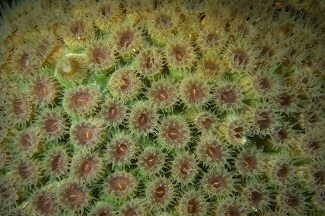Additional Coral Reef Resources
 Coral polyps in Grand Cayman. Photo credit: Ellen Cuylaerts/Coral Reef Image Bank.In addition to the EPA tools and resources, information on coral reefs may be accessed through the entities listed below.
Coral polyps in Grand Cayman. Photo credit: Ellen Cuylaerts/Coral Reef Image Bank.In addition to the EPA tools and resources, information on coral reefs may be accessed through the entities listed below.
On this page:
- National Marine Sanctuary System
- National Coral Reef Institute
- Southeast Florida Coral Reef Initiative
- Stormwater Management in the Islands
National Marine Sanctuary System
The National Marine Sanctuary System is a network of underwater parks encompassing more than 600,000 square miles of marine and Great Lakes waters. Visit the websites for Gray’s Reef, Florida Keys, Flower Garden Banks, Hawaiian Islands Humpback Whale, and American Samoa National Marine Sanctuaries to learn more about what is being done to protect and restore coral reefs.
National Coral Reef Institute
Scientists with Nova Southeastern University’s (NSU) National Coral Reef Institute conduct multidisciplinary research to assess, monitor, mitigate impacts, and restore coral reefs. To access numerous research products, software tools, and scientific publications visit NSU’s National Coral Reef Institute website.Exit
Southeast Florida Coral Reef Initiative
The Southeast Florida Coral Reef Initiative Exitis a partnership between government and non-governmental organizations, universities, and private partners. This collaborative group identifies and implements actions to reduce threats to coral reefs and is critical for making progress in protecting the coral reef ecosystems in Southeast Florida.
Stormwater Management in the Pacific and Caribbean Islands: A Practitioner’s Guide to Implementing Low Impact Development
The Stormwater management in Pacific and Caribbean Islands: A practitioner’s guide to implementing LID Exitis a guide for island stormwater practitioners seeking to apply a Low Impact Development (LID) approach to improve water quality treatment, rainwater reuse, and recharge. This guide provides a design framework for stormwater projects including information on developing designs and objectives, identifying the best site for LID, constructing and installing LID approaches.
